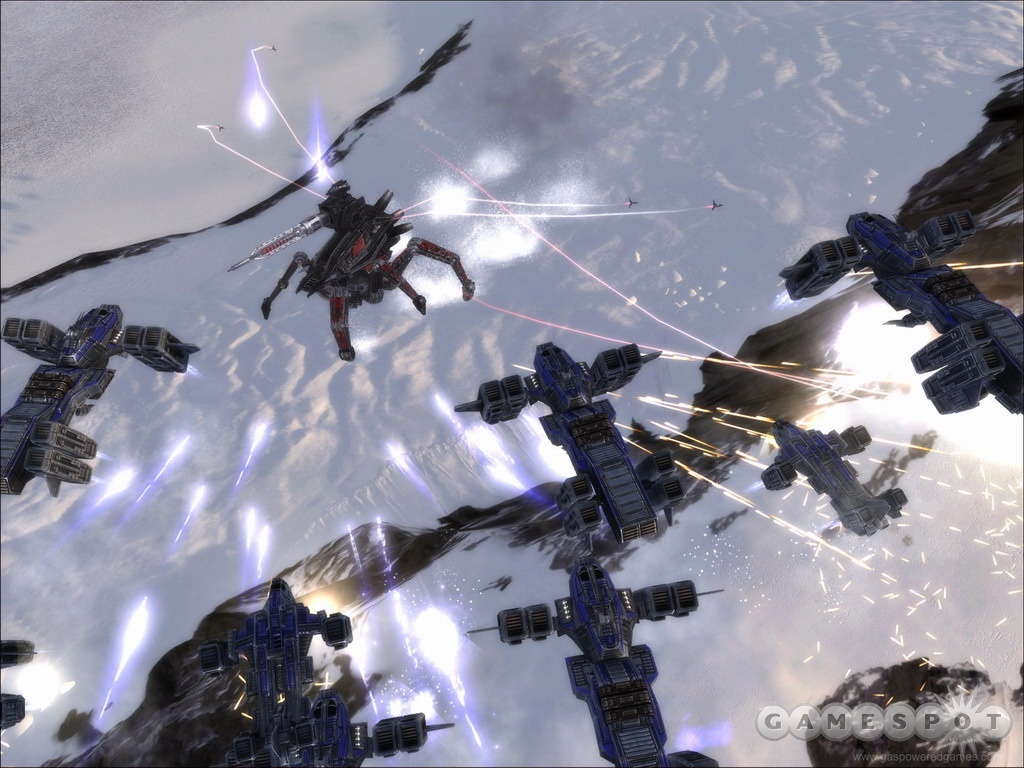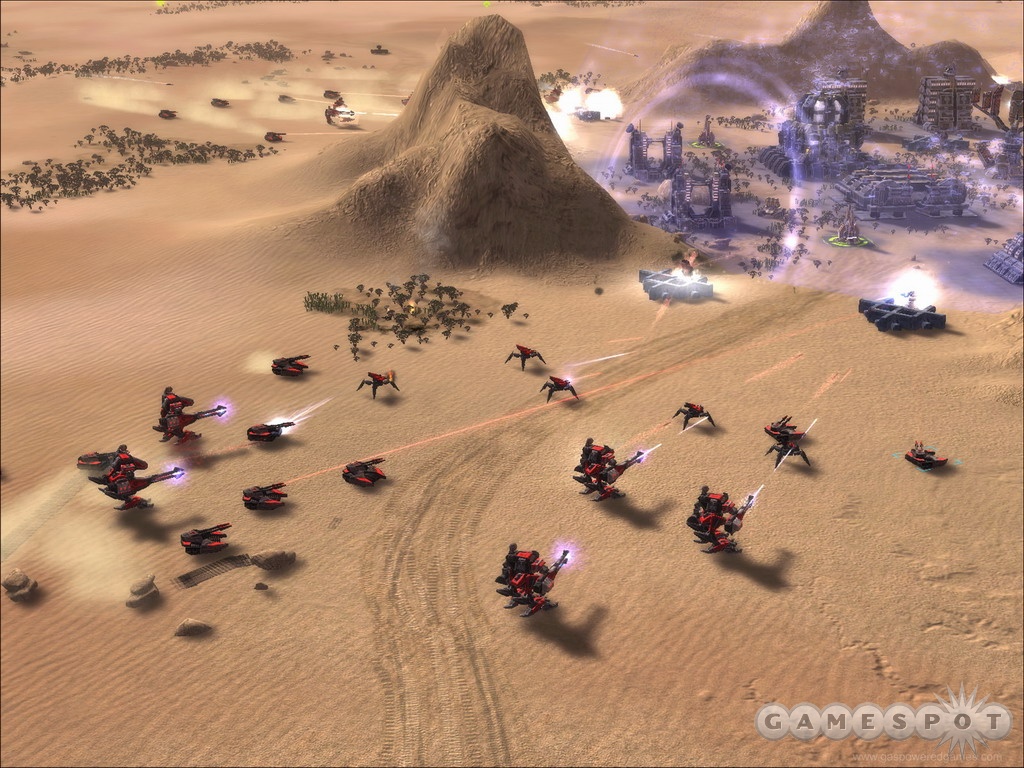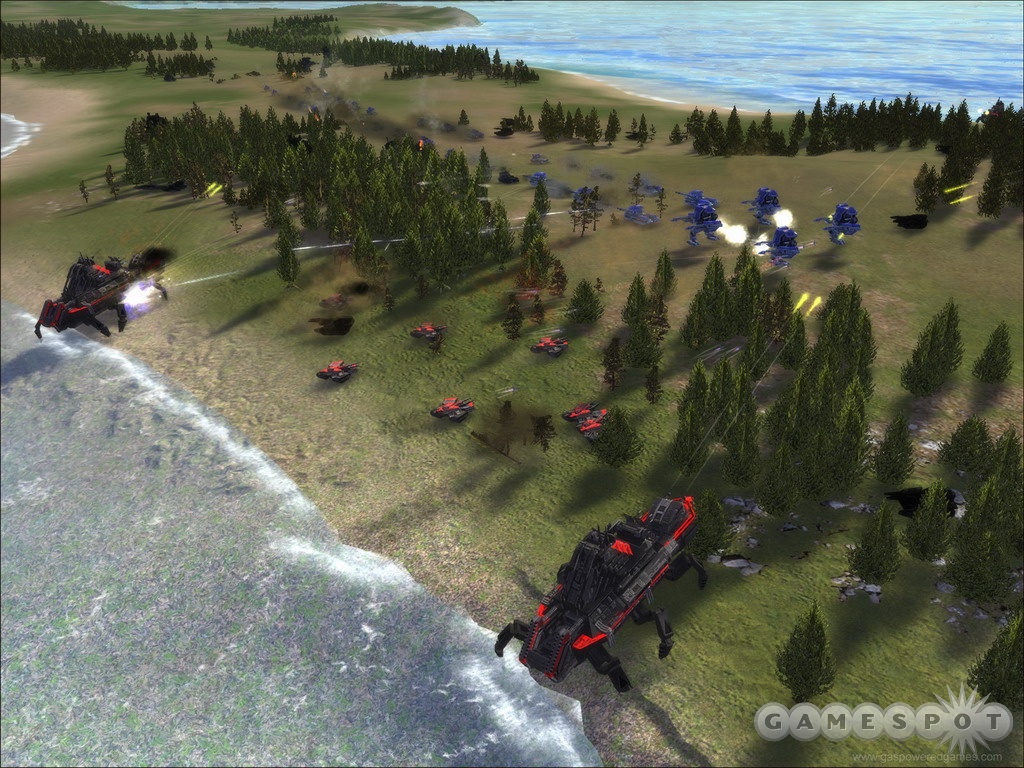Supreme Commander Updated Q&A - Logistics, Waypoints, and Multiplayer
Lead designer Bradley Rebh discusses some of the new systems and features designed to help you command huge armies in this sprawling real-time strategy game.
Supreme Commander is a game that follows a philosophy that bigger is definitely better. This real-time strategy game from THQ and Gas Powered Games is set in a distant future where three factions war on battlefields up to 50 miles wide. With this much room, you can create multiple bases from which to produce armies, navies, and air forces to sweep your enemies from the map. You can check out the action for yourself by downloading the recently released
GameSpot: Though it's set in the distant future, Supreme Commander seems like it's more a game about modern warfare. It seems like you're trying to get the player to think more about maneuvering on the battlefield. As such, how critical are transports to the game? Why will you have to worry about such things in Supreme Commander?

Bradley Rebh: Logistics is a very important aspect of war. It doesn't matter if you have more firepower than your opponent. If your units aren't deployed properly, you're toast. Transports quickly and efficiently move your land units where they'll be the most effective. Map conditions play a very large factor in the usefulness of transports. Distance, water, and impassable terrain may force the use of transports to make a land invasion viable. Smaller maps make transports less critical since units can react quickly on their own. Even on small maps, though, transports can be used to drop forces where your opponent will least expect them.
GS: We've noticed that there are air transports, but there are no naval transports. Is there a particular reason for this? Were naval transports too slow or cumbersome?
BR: In the early stages of development, we explored the concept of land and naval transports. Ultimately, we weren't satisfied with how we'd have to build them, so other game features took priority. We hope to reevaluate this feature down the road.
GS: The ferry system makes airlifting armies fairly simple. Could you explain how it works in detail and what the keys are for a successful airlift?
BR: The ferry system is one of my favorite user-interface innovations. With a transport selected, click the ferry order button and target a spot on the map (the destination point). The transport will "drop" a beacon icon. Select a bunch of land units and right-click the beacon. The units will move to the beacon and the transport will automatically load the units and then drop them off at the destination point. The transport will continue to move back and forth until all the units have been delivered.
Here are some advanced uses for the ferry order: Once you've set up a ferry route, you can select other transports and assign them to the beacon to have them share the ferrying responsibilities. If you hold the Shift key while placing multiple ferry waypoints, the transport will follow the path of the waypoints during the drop-off and will return along this same path. This lets you avoid the antiaircraft defenses of your opponent. And the rally point of land factories can be set to use a ferry beacon. Units that are built from these factories will get to the front line much faster than if the unit simply drove to a distant rally point.
GS: A lot of thought seems to have gone into the waypoint system. For example, you can queue up a lot of different commands for an engineer unit to keep it busy for a while. What other things can you do with the waypoint system?

BR: The waypoint system is extremely flexible. A favorite strategy around here is to set up interceptor fighter patrols early to protect against a bomber rush. As the game goes on and a base expands, there's no need to reissue the patrol for those units to cover more ground. Instead, you can simply click-drag the patrol path's waypoints to any shape or size that is desired. Also, waypoints are sometimes issued that are no longer wanted. With the Shift and Control keys held, you can right-click on a waypoint to delete them.
GS: How important is it to conduct coordinated attacks in the game? Could you give us an example of a successful coordinated strike? How easy is it to set one up?
BR: Coordinated attacks can be an extremely useful tool to ensure maximum force is applied to a target. This order is most effective when different groups of units will take different amounts of time to get to a target (either because of the speed of the units or the distances they have to cover). For instance, an order is issued to a group of tanks to attack an opponent's land factory. While holding the Shift key, the player can double right-click on the attack order of the tanks to coordinate this attack with a bombing run. The tanks and bombers will time their assault so they attack the target together, obliterating it.
GS: Could you discuss the importance of using combined arms in addition to coordinated attacks? There's no rock-scissors-paper-style balancing in the game, but there is a ruthless circle of life on the battlefield.
BR: We've said that there is no rock-paper-scissors in Supreme Commander, but that can be misinterpreted. We don't balance the game based on algorithms to determine a hit or miss, and damage isn't calculated through a comparison of damage type versus armor type like in most other real-time strategy games. Instead, we rely on a simulation to define the roles of a unit. For example, artillery tends to have slower-moving turrets and a high, slow trajectory to its shell. These attributes make it tough to hit a fast, mobile unit but have little impact on a nonmobile structure. On the other hand, bots typically wield fast-firing weaponry that can acquire targets quickly. This makes them better suited for hitting a moving target, but these weapons tend to do less damage than an artillery shell.
GS: Let's talk multiplayer. What multiplayer modes are there? How many players can you support? Were you able to keep the cooperative multiplayer mode with up to eight players that we discussed last year?
BR: Supreme Commander supports up to eight players. You can set different victory conditions and start options in the game lobby, and we're planning to release more down the road. I'm told by the engineering department that the engine can support more than 8 players if the maps and the game lobby were revised to accommodate those sizes. However, modern system specs won't be able to handle more than 8 players for a little while longer.

GS: In our experience, a single-player skirmish can easily last up to two hours. That length wouldn't easily translate to a multiplayer game. How much of an effect do the speed settings have in speeding up a multiplayer skirmish? Could you play a multiplayer game in under an hour?
BR: We've found that the size of a map is the biggest factor when timing a game. Our smallest maps (5km x 5km) are meant to last much less than an hour, while the largest maps (81km x 81km) can provide weekend-long epic slugfests!
GS: Good to know. Thanks Bradley.
Got a news tip or want to contact us directly? Email news@gamespot.com
Join the conversation